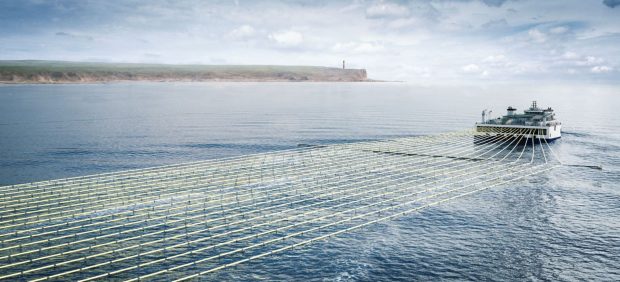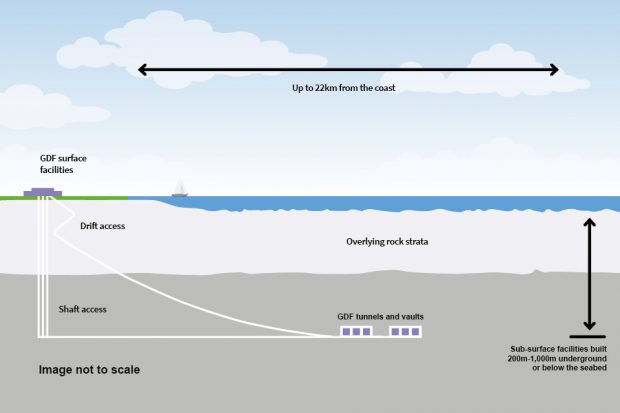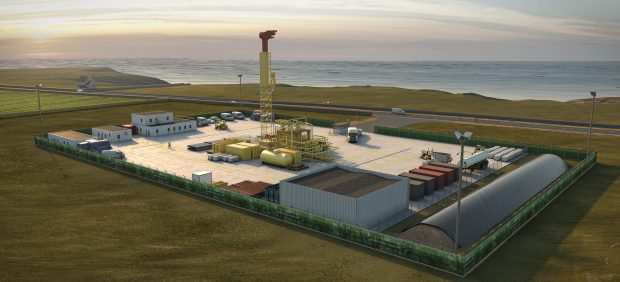
We're willing to explore any areas identified
As we begin to discuss the prospect of hosting a deep geological facility with our first Working Groups and the wider communities around them, one of the interesting questions we’ve come across is whether it’s feasible to construct the underground part of a facility deep below the seabed.
The simple answer is ‘yes’ - if Working Groups ask us to look at this option, we’re very willing to explore any areas that are identified, either close to the coast or extending up to the 22km outer limit of UK territorial waters.

It’s important to emphasise that we would need further, much more detailed investigations to understand whether any areas could be realistic possibilities, and we don’t expect to reach this position for a number of years.
Research down the years
Exploring the suitability of rocks deep below the seabed off our coast has been a consideration for many years. RWM is actively involved in research that would inform future decision-making if a sub-seabed location becomes of interest for a community.
Numerous wide-ranging studies have been carried out both in the UK and overseas, since scientists and engineers first looked into how best to deal with the radioactive waste that has been accumulating since research into atom-splitting technologies began to gather pace in the post-war years.
During the early decades of nuclear experimentation, the focus was on making the technology work safely and efficiently: little attention was paid to future decommissioning or dealing with the radioactive waste products.
Numerous solutions were considered in the past, ranging from disposal in ice sheets, on the ocean floor, rock melting and firing the waste into outer space.
The right thing to do
Today, science and environmental standards have advanced and the internationally recognised solution for radioactive waste is geological disposal – because we know it’s is the right thing to do. This comprises a land-based surface facility connected to engineered vaults and tunnels that are deep underground. The underground part of the facility could be wholly or partially below the seabed.
Internationally, precedents already exist. Sweden has a disposal facility for Intermediate Level Waste (ILW) 60 metres below the floor of the Baltic Sea, which opened in the 1980s. The global oil and gas industry has been drilling deep below the seabed for decades. Think too of the Channel Tunnel or Boulby Mine on the east coast which is more than 1,000 metres below the seabed and extends to approximately 10 miles off the coast.
A GDF deep below the seabed
For the UK, a prospective GDF below the seabed off our coastline could definitely be worth investigating.
From a geological perspective, there is in fact little difference between a GDF constructed within rocks under land or within rocks under the seabed. A GDF exists to isolate the waste from the surface environment, and providing the correct geological environment is selected, it makes little difference what is going on in that surface environment – land or sea. In either scenario, the depths of rock above ensure protection for many thousands of years.
What's absolutely clear is that while a GDF could be built hundreds of metres below the seabed, we aren't going to dispose of waste on the seabed itself.
Compared to a land-based GDF, there are different challenges and considerations, such as avoiding disruption to marine environments during preliminary investigations and construction. We would also need to liaise with a different set of stakeholders, such as those in the fishing and maritime sectors.
But our priorities would remain the same: safety and security, plus full compliance with all the regulatory criteria.
A GDF under the seabed is also likely to require infrastructure improvements on land, perhaps expanding an existing port or constructing a new one, which could have spin-off benefits for a local community.
Research and engagement with communities
The search areas, however, will be defined by the working groups and the eventual selection of a site, whether on land or below the seabed, will be very much influenced by the views and feedback expressed during local community discussions. And of course, a site would need to be comprehensively investigated and confirmed as geologically suitable.

In the meantime, RWM is in the process of examining all the previous research relating to disposal under the seabed, and has commissioned further studies to understand in greater detail how to proceed with geological investigations, together with the design and construction of sub-seabed facility – if this is what we’re asked to explore.
These reports will add to the information already available and help to inform continued discussions about possible locations both on land and under the seabed. We look forward to the outcomes!
6 comments
Comment by Tim Knowles posted on
If an undersea location accessed from Sellafield was chosen wouldn't the sheer scale of workings "up to 22km" from shore bring it under Isle of Man territorial waters? The Isle of Man government were always part of Sellafields local liaison structure, will they & the IOM public be consulted if such an option is considered?
Comment by Radioactive Waste Management posted on
22km is the limit of UK territorial waters, below which a facility could be considered somewhere. By definition, this is not below Isle of Man territorial waters, which lie some further distance beyond the UK limit. Two Working Groups have been formed in west Cumbria, however, a prospective search area has yet to be identified. RWM expects more Working Groups to form in other parts of the country. A GDF will only be built where we find a suitable site together with a willing host community. The views of all interested stakeholders will be taken into account.
Comment by Julia Wilson posted on
I see there is a huge challenge ahead and it goes to show how irresponsible the inventors of nuclear power were in the first place. I've been against nuclear from the start because of the lack of security with waste disposal. I'm not a scientist but I do know the Earth's crust is always moving with fissures leaking all the time. Instead of photosynthesis the ocean depths have thermosynthesis and creatures thrive on the spouting heat for their survival. Messing around with any depths is never going to be an eternal solution and I question if nuclear waste is something we want to spring on future, unsuspecting generations.
Comment by Radioactive Waste Management posted on
An operational GDF would be many hundreds of metres below the seabed, where rocks are very stable so it wouldn't affect creatures living in the sea or the marine environment.
Comment by Colin Wales posted on
Could a community within Allerdale take a vote to "rule itself out" in advance of any areas targeted by the working group as somewhere they wished to investigate?
Comment by Radioactive Waste Management posted on
Individuals and organisations are welcome to share their views about possible Search Areas at any time. The government's policy states that local discussions would end if the principal local authorities on a Community Partnership agreed to exercise the Right of Withdrawal. Any Community Partnership will engage with local people and monitor opinion to understand views in specific areas. Ultimately, there would have to be a Test of Public Support in any potential host community before a GDF could go ahead - so the local people will have the final say.